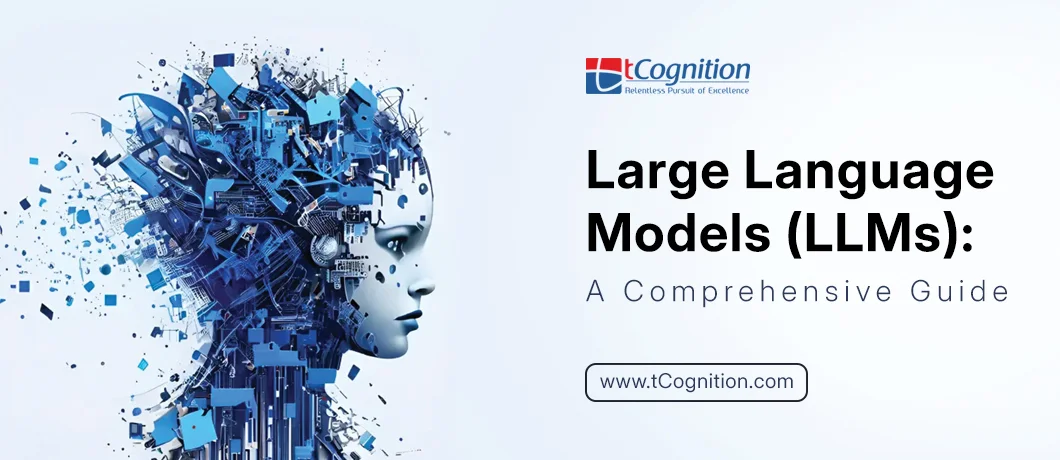Large Language Models (LLMs) have emerged as a transformative technology in the field of artificial intelligence (AI). They have revolutionized how machines understand and generate human language, impacting various industries and applications. In this blog, we will delve into what LLMs are, their importance, how they work, their applications, their future, and the differences between GPT and LLM.
What are Large Language Models?
Large Language Models (LLMs) are a type of artificial intelligence model designed to understand, generate, and interact with human language. They are built using deep learning techniques, specifically neural networks, that have been trained on vast amounts of text data. The goal of an LLM is to understand context, semantics, and syntax in human language, allowing it to perform tasks such as translation, summarization, question-answering, and even creative writing.
LLMs are characterized by their massive scale, often consisting of billions of parameters. These parameters are the weights and biases within the neural network that the model learns during training. The large number of parameters enables LLMs to capture intricate patterns and nuances in language, making them capable of generating highly coherent and contextually relevant text.
Why are Large Language Models Important?
The importance of LLMs lies in their ability to transform various domains by enhancing natural language understanding and generation. Here are some key reasons why LLMs are crucial:
Enhanced Communication: LLMs enable machines to interact with humans more naturally, improving user experiences in applications like chatbots, virtual assistants, and customer support.
Automation: They can automate content creation, data analysis, and other tasks that require understanding and generating human language, leading to increased productivity.
Accessibility: LLMs help make information and services more accessible by providing real-time translations, transcriptions, and summaries.
Innovation: They drive innovation in fields like healthcare, education, and entertainment by powering applications such as diagnostic tools, personalized learning platforms, and creative content generation.
How Do Large Language Models Work?
LLMs work by leveraging deep learning architectures, primarily transformers. Here is a simplified explanation of their functioning:
Data Collection: The training process begins with collecting large datasets of text from diverse sources such as books, articles, websites, and social media.
Preprocessing: The text data is preprocessed to convert it into a format suitable for training. This involves tokenization, where text is broken down into smaller units called tokens.
Training: The core of an LLM is the neural network, typically a transformer model. During training, the model learns to predict the next word or token in a sentence given the previous words. This process involves adjusting the model’s parameters to minimize the prediction error.
Fine-tuning: After the initial training, the model can be fine-tuned on specific tasks or domains to improve its performance in those areas.
Inference: Once trained, the LLM can be used for various applications by inputting text and generating responses based on its learned knowledge.
Applications of Large Language Models:
LLMs have a wide range of applications across different sectors. Some prominent applications include:
Natural Language Processing (NLP): Tasks like sentiment analysis, entity recognition, and language translation are greatly enhanced by LLMs.
Content Creation: LLMs can generate articles, reports, stories, and even poetry, assisting writers and creators.
Customer Support: Virtual assistants and chatbots powered by LLMs provide efficient and accurate customer service.
Healthcare: LLMs aid in medical research, diagnostics, and personalized patient care through the analysis of medical records and literature.
Education: LLMs make personalized tutoring systems and educational content creation possible.
Entertainment: LLMs contribute to scriptwriting, game development, and interactive storytelling.
Future of Large Language Models:
The future of LLMs is promising, with several advancements and trends expected to shape their evolution:
Increased Scale: LLMs will continue to grow in size and complexity, leading to even more accurate and nuanced language understanding and generation.
Specialization: Future LLMs will be tailored to specific industries and tasks, enhancing their effectiveness in specialized applications.
Efficiency: Efforts to make LLMs more energy-efficient and faster will be crucial, addressing the computational challenges associated with their large size.
Ethical Considerations: As LLMs become more pervasive, addressing ethical concerns such as bias, privacy, and misuse will be paramount.
Integration with Other Technologies: LLMs will increasingly be integrated with other AI technologies, such as computer vision and robotics, to create more comprehensive and intelligent systems.
What is the Difference Between GPT and LLM?
GPT, or Generative Pre-trained Transformer, is a specific type of LLM developed by OpenAI. While all GPT models are LLMs, not all LLMs are GPTs. Here are some key distinctions:
Architecture: GPT models are based on the transformer architecture, which is also used by other LLMs. However, the specific design and training objectives may vary.
Pre-training and Fine-tuning: GPT models undergo a two-step process of pre-training on large datasets followed by fine-tuning for specific tasks. Other LLMs may follow different training protocols.
Variants: GPT has several versions (GPT-2, GPT-3, etc.), each with increasing size and capabilities. Other LLMs may have different versions and naming conventions.
Developer: GPT is developed by OpenAI, whereas other LLMs are developed by various organizations, including Google (BERT), Microsoft (Turing NLG), and more.
In conclusion, Large Language Models represent a significant advancement in AI, enabling machines to understand and generate human language with remarkable proficiency. Their impact spans across multiple industries, driving innovation, efficiency, and accessibility. As we look to the future, continued advancements in LLM technology promise to further transform how we interact with and benefit from AI.

